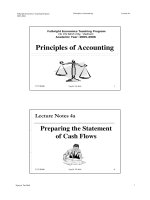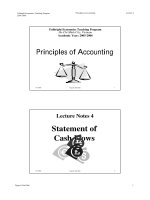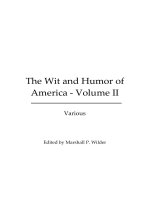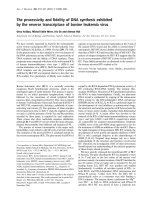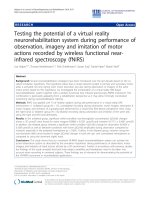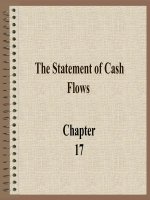The Income Statement and Statement of Cash Flows4Copyright © 2007 by The McGraw-Hill Companies, docx
Bạn đang xem bản rút gọn của tài liệu. Xem và tải ngay bản đầy đủ của tài liệu tại đây (485.67 KB, 19 trang )
1
Copyright © 2007 by The McGraw-Hill Companies, Inc. All rights reserved.
The Income
Statement and
Statement of
Cash Flows
4
4-2
Learning Objectives
Explain the difference between net income and
comprehensive income and how we report
components of the difference.
4-3
Comprehensive Income
An expanded
version of income
that includes four
types of gains and
losses that
traditionally have
not been included
in income
statements.
2
4-4
Other Comprehensive Income
Statement of Financial Accounting Standards No. 130
Comprehensive income includes traditional net income
and changes in equity from nonowner transactions.
1. Changes in the market value of securities available for sale
(described in Chapter 12).
2. Gains, losses, and amendment costs for pensions and other
postretirement plans (described in Chapter 17).
3. When a derivative is designated as a cash flow hedge is adjusted to
fair value, the gain or loss is deferred as a component of
comprehensive income and included in earnings later, at the same
time as earnings are affected by the hedged transaction (described in
Chapter 14).
4. Gains or losses from changes in foreign currency exchange rates
(discussed elsewhere in your accounting curriculum).
4-5
Accumulated Other Comprehensive Income
In addition to reporting comprehensive income that
occurs in the current period, we must also report these
amounts on a cumulative basis in the balance sheet as
an additional component of shareholders’ equity.
(In millions, except shares) 2004 2003
Common Stockholders' Investment:
Common stock, $.10 par value , 800 million
shares authorized, 300 million shares
issued for 2004 and 299 million shares 30$ 30$
issued for 2003
Additional pa id-in capital 1,079 1,088
Retained earnings 7,001 6,250
Accumula ted other comprehensive loss (46) (30)
8,064 7,338
Less deferred compensation and treasury
stock at cost 28 50
Total common stockholders' investment 8,036$ 7,288$
FedEx Corporation
Balance Sheet
31-May
4-6
Learning Objectives
Discuss the importance of income from
continuing operations and describe its
components.
3
4-7
Expenses
Outflows of
resources
incurred in
generating
revenues.
Revenues
Inflows of
resources
resulting
from
providing
goods or
services to
customers.
Gains and
Losses
Increases or
decreases in
equity from
peripheral or
incidental
transactions
of an entity.
Income from Continuing Operations
Income Tax
Expense
Because of
its
importance
and size,
income tax
expense is a
separate
item.
4-8
Operating
Income
Nonoperating
Income
Operating Income Versus Nonoperating
Income
Includes revenues
and expenses
directly related to
the principal
revenue-
generating
activities of the
company
Includes gains and
losses and
revenues and
expenses related
to peripheral or
incidental
activities of the
company
4-9
Income Statement (Single-Step)
Expenses
& Losses
{
MAXWELL GEAR COMPANY
Income Statement
For the Year Ended December 31, 2006
Revenues and gains:
Sales 573,522$
Interest and dividends 26,400
Gain on sale of opearting assets 5,500
Total revenues and gains 605,422
Expenses and losses:
Cost of goods sold 302,371$
Selling 47,341
General and administrative 24,888
Research and development 16,300
Interest 6,200
Loss on sale of investment 8,322
Income taxes 80,000
Total expenses & losses 485,422
Net income 120,000$
{
Revenues
& Gains
{
Proper Heading
4
4-10
Income Statement (Multiple-Step)
{
Non-
operating
Items
MAXWELL GEAR CORPORATION
Income Statement
For the Year Ended December 31, 2006
Sales revenue 573,522$
Cost of goods sold 302,371
Gross profit 271,151
Operating expenses:
Selling 47,341$
General and administrative 24,888
Research and development 16,300 88,529
Operating income 182,622
Other income (expense):
Interest and dividend revenue 26,400$
Gain on sale of operating assets
5,500
Interest expense (6,200)
Loss on sale of investments (8,322) 17,378
Income before income taxes 200,000
Income tax e xpense 80,000
Net income 120,000$
{
Gross
Profit
{
Proper Heading
Operating
Expenses
{
4-11
Learning Objectives
Describe earnings quality and how it is
impacted by management practices to
manipulate earnings.
4-12
Earnings Quality
Earnings quality refers to
the ability of reported
earnings to predict a
company’s future.
The relevance of any
historical-based financial
statement hinges on its
predictive value.
5
4-13
Manipulating Income and Income Smoothing
“Most managers prefer to report earnings that follow a
smooth, regular, upward path.”
1
Two ways to manipulate income:
1. Income shifting
2. Income statement
classification
1
Bethany McLean, “Hocus-Pocus: How IBM Grew 27% a Year,” Fortune, June 26, 2000, p. 168.
4-14
Learning Objectives
Discuss the components of operating and
nonoperating income and their relationship to
earnings quality.
4-15
Operating Income and Earnings Quality
Should all items of revenue and expense included in
operating income be considered indicative of a
company’s permanent earnings?
No, not necessarily.
Operating expenses may include the following unusual items
that may or may not continue in the future:
• Restructuring costs
• Goodwill impairment
• Long-lived asset impairment
• In-process research and development
6
4-16
Operating Income and Earnings Quality
Restructuring Costs
Costs associated with shutdown or
relocation of facilities or
downsizing of operations are
recognized in the period incurred.
Goodwill Impairment
and Long-lived Asset
Impairment
Involves asset impairment losses
or charges (discussed further in
Chapters 10 & 11).
In-process Research
and Development
Results from certain business
combinations (discussed further in
Chapter 10).
4-17
Nonoperating Income and Earnings Quality
Gains and losses from the sale of operational
assets and investments often can significantly
inflate or deflate current earnings.
Example
As the stock market boom reached its
height late in the year 2000, many
companies recorded large gains from
sale of investments that had
appreciated significantly in value.
How should
those gains be
interpreted in
terms of their
relationship to
future
earnings? Are
they transitory
or permanent?
4-18
Pro Forma Earnings
Companies often voluntarily provide a pro forma
earnings number when they announce annual or
quarterly earnings. Pro forma earnings are
management’s assessment of permanent earnings.
The Sarbanes-Oxley Act
Section 401 requires a
reconciliation between pro
forma earnings and
earnings determined
according to GAAP.
7
4-19
Separately Reported Items
Reported separately, net of taxes:
Discontinued
operations
$ xxx
xx
xxx
xx
xx
Net Income $ xxx
Extraordinary items (net of $xx in
taxes)
Income from continuing operations
before income taxes and
extraordinary items
Income tax expense
Income from continuing operations
before extraordinary items
Discontinued operations (net of $xx
in taxes)
Extraordinary
items
A third item, the
cumulative effect of
a change in
accounting
principle, was
eliminated from
separate reporting
by a new
accounting
standard in 2005.
4-20
Intraperiod Income Tax Allocation
Income Tax Expense must be associated with
each component of income that causes it.
Show Income Tax
Expense related to
Income from
Continuing
Operations.
Report effects of
Discontinued Operations
and Extraordinary Items
NET OF RELATED
INCOME TAXES.
4-21
Learning Objectives
Define what constitutes discontinued
operations and describe the appropriate
income statement presentation for these
transactions.
8
4-22
p
A discontinued operation is the sale or
disposal of a component of an entity.
p
A component comprises operations and
cash flows that can be clearly
distinguished, operationally and for
financial reporting purposes, from the rest
of the entity.
p A component could include:
p
Reportable segments
p
Operating segments
p Reporting units
p
Subsidiaries
p
Asset groups
Discontinued Operations
4-23
Discontinued Operations
Report results of operations separately if two
conditions are met:
The operations and
cash flows of the
component have been
(or will be) eliminated
from the ongoing
operations.
The entity will not have
any significant
continuing involvement
in the operations of the
component after the
disposal transaction.
4-24
Discontinued Operations
Reporting for Components Sold
Operating income or
loss of the component
from the beginning of
the reporting period to
the disposal date.
Gain or loss on the
disposal of the
component.
Reporting for Components Held For Sale
Operating income or
loss of the component
from the beginning of
the reporting period to
the end of the reporting
period.
An “impairment loss” if
the carrying value of
the assets of the
component is more
than the fair value
minus cost to sell.
9
4-25
During the year, Apex Co. sold an
unprofitable component of the company. The
component had a net loss from operations
during the period of $150,000 and its assets
sold at a loss of $100,000. Apex reported
income from continuing operations of
$128,387. All items are taxed at 30%.
How will this appear in the income
statement?
Discontinued Operations Example
4-26
Loss from discontinued operations (150,000)$
Less: Tax benefit ($150,000 × 30%) 45,000
Net loss (105,000)$
Loss on disposal of assets (100,000)$
Less: Tax benefit ($100,000 × 30%) 30,000
Net loss (70,000)$
Discontinued Operations Example
Computation of Loss from Discontinued Operations
(Net of Tax Effect):
4-27
Income from continuing operations 128,387$
Discontinued operations:
Loss from operations of discontinued
component (net of tax benefit of
$45,000) (105,000)
Loss on disposal of discontinued
component (net of tax benefit of
$30,000) (70,000)
Net loss (46,613)$
Income Statement Presentation:
Discontinued Operations Example
10
4-28
Learning Objectives
Define extraordinary items and describe the
appropriate income statement presentation for
these transactions.
4-29
p
Material events or
transactions
p
Unusual in nature
p
Infrequent in occurrence
p
Reported net of related
taxes
Extraordinary Items
4-30
During the year, Apex Co. experienced a
loss of $75,000 due to an earthquake at one
of its manufacturing plants in Nashville.
This was considered an extraordinary item.
The company reported income before
extraordinary item of $128,387. All gains
and losses are subject to a 30% tax rate.
How would this item appear in the
income statement?
Extraordinary Items Example
11
4-31
Extraordinary Loss (75,000)$
Less: Tax Benefits
($75,000 × 30%) 22,500
Net Loss (52,500)$
Income before extraordinary item 128,387$
Extraordinary Loss:
Earthquake loss
(net of tax benefit of $22,500) (52,500)
Net income 75,887$
Income Statement Presentation:
Extraordinary Items Example
Computation of Loss from Extraordinary Item (Net of
Tax Effect):
4-32
Unusual or Infrequent Items
Items that are material and are either
unusual or infrequent—but not both—
are included as a separate item in
continuing operations.
4-33
Type of Accounting
Change Definition
Change in Accounting
Principle
Change from one GAAP method
to another GAAP method
Change in Accounting
Estimate
Revision of an estimate
because of new information or
new experience
Change in Reporting
Entity
Preparation of financial
statements for an accounting
entity other than the entity that
existed in the previous period
Accounting Changes
12
4-34
Learning Objectives
Describe the measurement and reporting
requirements for a change in accounting
principle.
4-35
Change in Accounting Principle
p
Occurs when changing from one GAAP
method to another GAAP method
n
For example, a change from LIFO to FIFO
p
Voluntary changes in accounting
principles are accounted for
retrospectively by revising prior years’
financial statements.
p
Changes in depreciation, amortization, or
depletion methods are accounted for the
same way as a change in accounting
estimate.
4-36
Learning Objectives
Explain the accounting treatments of changes
in estimates and correction of errors.
13
4-37
Change in Accounting Estimate
Revision of a
previous accounting
estimate
Use new estimate in
current and future
periods
Includes treatment for
changes in depreciation,
amortization, and
depletion methods
4-38
Change in Accounting Estimate Example
On January 1, 2003, we purchased
equipment costing $30,000, with a useful
life of 10 years and no salvage value.
During 2006, we determine that the
remaining useful is 5 years (8-year total
life). We use straight-line depreciation.
Compute the revised depreciation
expense for 2006.
4-39
Asset cost 30,000$
Accumulated depreciation
12/31/05 - ($3,000 × 3 years) (9,000)
Remaining to be depreciated 21,000
Remaining useful life ÷ 5 years
Revised annual depreciation 4,200$
Record depreciation expense of $4,200 for
2006 and subsequent years.
Change in Accounting Estimate Example
GENERAL JOURNAL
Page: 180
Date Description PR Debit Credit
4,200
Accumulated Depreciation 4,200
Depreciation Expense
14
4-40
Change in Reporting Entity
If two entities
combine, a single
set of consolidated
financial
statements is
generally required.
4-41
Change in Reporting Entity
A change in reporting
entity is reported by
restating all previous
periods’ financial
statements presented
for comparative
purposes as if the new
reporting entity existed
in those periods.
4-42
p
Corrections of errors from a
previous period
p
Appear in the Statement of
Retained Earnings as an
adjustment to beginning
retained earnings
p
Must show the adjustment
net of income taxes
Prior Period Adjustments
15
4-43
Prior Period Adjustments Example
While reviewing the depreciation entries for
2002-2007, the controller found that in 2006
depreciation expense was incorrectly debited
for $150,000 when in fact it should have been
debited $125,000. (Ignore income taxes.)
Prepare the necessary journal entry in 2007 to
correct this prior period error.
GENERAL JOURNAL
Page: 180
Date Description PR Debit Credit
12/31/06 Depreciation Expense 150,000
Accumulated Depreciation 150,000
4-44
GENERAL JOURNAL
Page: 180
Date Description PR Debit Credit
Accumulated Depreciation 25,000
Retained Earnings 25,000
2007 Entry
Prior Period Adjustments Example
4-45
Learning Objectives
Define earnings per share (EPS) and explain
required disclosures of EPS for certain income
statement components.
16
4-46
Earnings Per Share Disclosure
One of the most widely used ratios is earnings per
share (EPS), which shows the amount of income
earned by a company expressed on a per share basis.
Basic EPS
Net income less preferred dividends
Weighted-average number of
common shares outstanding for the
period
Diluted EPS
Reflects the potential dilution that could
occur for companies that have certain
securities outstanding that are convertible
into common shares or stock options that
could create additional common shares if
the options were exercised.
4-47
Earnings Per Share Disclosure
Report EPS data separately for:
1. Income from Continuing Operations
2. Separately Reported Items
a) Discontinued Operations
b) Extraordinary Items
3. Net Income
4-48
Learning Objectives
Describe the purpose of the statement of cash
flows.
17
4-49
The Statement of Cash Flows
p
Provides relevant information about a
company’s cash receipts and cash
disbursements.
p
Helps investors and creditors to assess
n
future net cash flows
n
liquidity
n
long-term solvency.
p
Required for each income statement period
presented.
4-50
Learning Objectives
Identify and describe the various classifications
of cash flows presented in a statement of cash
flows.
4-51
Operating Activities
Cash
Flows
from
Operating
Activities
Inflows from:
l
Sales to customers.
l
Interest and dividends
received.
+
Outflows
to:
Outflows to:
l
Purchase of inventory.
l
Salaries, wages, and other
operating expenses.
l Interest on debt.
l
Income taxes.
_
18
4-52
Direct and Indirect Methods of Reporting
Two Formats for Reporting Operating Activities
Reports the cash
effects of each
operating activity
Direct Method
Starts with
accrual net
income and
converts to cash
basis
Indirect Method
4-53
Direct and Indirect Methods
Cash flows from Operating Activities
Cash received from customers 78$
Cash paid for administrative expenses (25)
Net cash flows from operating activities 53$
ARLINGTON LAWN CARE
Statement of Cash Flows
For the Year Ended December 31, 2006
($ in thousands)
Direct
Method
Cash flows from Operating Activities
Net income 35$
Adjustments for noncash effects:
Depreciation expense 8$
Increase in accounts receivable (12)
Increase in accounts payable 7
Increase in income taxes payable 15 18
Net cash flows from operating activities 53$
ARLINGTON LAWN CARE
Statement of Cash Flows
For the Year Ended December 31, 2006
($ in thousands)
Indirect
Method
4-54
Cash
Flows
from
Investing
Activities
+
Investing Activities
Inflows
from:
Inflows from:
l Sale of long-term assets used in
the business.
l
Sale of investment securities
(stocks and bonds).
l
Collection of nontrade
receivables.
_
Outflows to:
l
Purchase of long-term assets
used in the business.
l
Purchase of investment
securities (stocks and bonds).
l
Loans to other entities.
19
4-55
Cash
Flows
from
Financing
Activities
+
_
Financing Activities
Inflows from:
l
Sale of shares to owners.
l
Borrowing from creditors
through notes, loans,
mortgages, and bonds.
Outflows
to:
Outflows to:
l Owners in the form of dividends
or other distributions.
l
Owners for the reacquisition of
shares previously sold.
l
Creditors as repayment of the
principal amounts of debt.
4-56
Noncash Investing and Financing Activities
Significant investing and financing
transactions not involving cash also
are reported.
Acquisition of equipment (an investing activity) by
issuing a long-term note payable (a financing
activity).
4-57
End of Chapter 4
